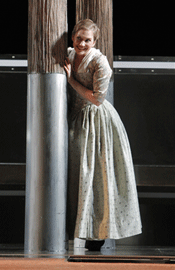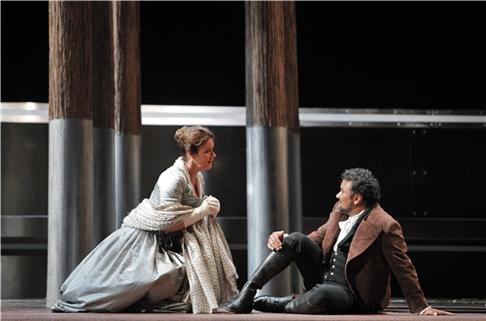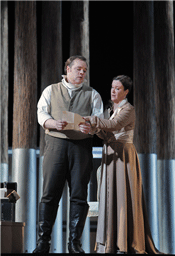24 Sep 2010
Werther in San Francisco
It has been twenty-five years since San Francisco Opera has staged a Werther. so it was high time that Massenet’s whiney, weepy masterpiece be given another chance.

It has been twenty-five years since San Francisco Opera has staged a Werther. so it was high time that Massenet’s whiney, weepy masterpiece be given another chance.
How it fared in 1985 is an interesting speculation, as its famed Werther, Alfredo Kraus was then 57 years-old and his Charlotte was the famed verismo diva Renata Scotto in decline.
Just now the Werther was entrusted to 50 year-old Ramón Vargas. Just two years ago Mr. Vargas was the perfect embodiment of an adorable Nemorino in the SFO Elisir d’amore. His career however generally has traversed larger lyric tenor roles — Rodolfo, Lenski, Don Carlo, etc. — for which he has perfected the physical delivery. Unfortunately this famous Mexican tenor no longer seems to be able to muster the vocal heft to match the gestures. Lacking now was the sense of vocal push and emotional release that makes a tenor, and therefore Werther exciting.
 Heidi Stober as Sophie
Heidi Stober as Sophie
Likewise his Charlotte, British mezzo Alice Coote gave a problematic performance. She is a lovely artist in prime condition whose fame has accrued primarily in the Baroque repertory. But the studied musicality that made her an ideal Idamante in SFO’s 2008 Idomeneo did not serve her in this foray into the French dramatic mezzo repertory. Unlike Mr. Vargas she has not absorbed the gestures and mannerisms of this repertory, an attribute that this production exploited by inducing too much realistic detail into her acting. Coupled with self-conscious musicality her performance was hard to watch.
Conductor Emmanuel Villaume however supplied everything these artists lacked, and created what was a memorable performance, his orchestra whining and weeping convincingly and crying out in full throat and throttle, his expansive tempos relentlessly driving the despair first of Werther and finally of Charlotte. Massenet’s tear-jerker is replete with much opportunity for the double reeds to freely emote and that the fine players of the San Francisco Opera Orchestra did with abandon.
The flawed performances of the protagonists were overwhelmed indeed by Mo. Villaume’s orchestral outpourings and were exacerbated by the set of this new production that elevated the singers and placed them somewhat behind the proscenium arch, a positioning that proved visually and acoustically remote. [This observation was based on sitting in the eighteenth row. At another, performance seated in the third row, these problems disappeared.]
This brand new production, directed by Francisco Negrin and designed by Louis Désiré, is challenging and interesting, attributes that are rare these days at SFO. The intent of the production was apparently to supply the world in which Werther and Charlotte’s story evolved with the innumerable complexities hinted at in the libretto but not present in Massenet’s score. The practical intent was perhaps to insert action into a libretto of static emotional and dramatic situations.
 Ramón Vargas as Werther and Alice Coote as Charlotte
Ramón Vargas as Werther and Alice Coote as Charlotte
The frenzy of subtext that resulted did not illuminate the simple, direct emotions of the Massenet score but rather created a vibrant ambience for Massenet’s ultimate, over-the-top dénouement. Any attempt at analysis of this imposed subtext seems useless as it hardly matters to the emotional gravity of the story that Sophie is head-over-heels in love with Werther or that Albert reads Werther’s letters alongside Charlotte and lies beside her in the marriage bed while she imagines Werther reciting Ossian. These real and imagined complications were sometimes amusing and other times annoying.
All this was effected in a frenzy of staging clichés — piles of furniture, the doubling of characters by actors, scribbling on a wall, lines of neon light, reflective surfaces, post-modern mix of materials and images, shuttering effects of light and image, not to forget the obligatory use of video. But all were put to good use, and even effective once the irritation of seeing these hackneyed tricks hit the stage once again was forgotten.
 Alice Coote as Charlotte and Brian Mulligan as Albert
Alice Coote as Charlotte and Brian Mulligan as Albert
Of particularly fine effect was the use of actor doubles for the dying Werther (making three of them!) allowing Charlotte to kneel over a splayed Werther while the erect Vargas/Werther held forth pathetically nearby and the third sat motionless facing upstage. Perhaps there was even a fourth Werther as someone held a torch in upstage blackness all through this long death scene.
It had come as a bit of a surprise when Charlotte donned the black dress in which she emoted over dying Werther — for the first three acts she was kept emotionally aloof and physically far away so it was hard to accept that she suddenly raced to his side.
The set architecture was based on horizontal bands — Werther’s garret on stage level, above that the stage-wide platform on which all life unfolded like on a cinemascope movie screen (even silver hued because of reflective metal walls). And above that floated intermittently a band of photographs of, inexplicably, some old New England houses variously modified from time to time to illustrate mood. A few vertical leafless metallic trees tried to function as an indication of season.
Mr. Vargas and Mme. Coote executed their roles with obvious respect for the production. Baritone Brian Mulligan was directed to an unrelenting oafish presence for Albert that precluded the admittance of any depth to his character. Soprano Heidi Stober brought vitality and vocal brilliance to Sophie in the evening’s only sympathetic performance. The unusually fine supporting cast (the bailiff and his cronies) though too young managed to bring their roles vocally and dramatically alive.
This Werther is co-produced by Lyric Opera of Chicago where presumably it will appear in the 2011-12 season. With another cast it may take on a depth it lacked here in San Francisco.
Michael Milenski